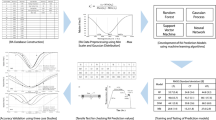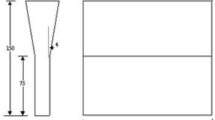Abstract
In various industries, e.g., manufacturing, railways, and automotive, austempered ductile iron (ADI), is extensively used because of its desirable characteristics for example, high tensile strength with good ductility. The hardness and ductility of ADI can be tailor-made for a specific application by following an appropriate process. Such characteristics can be achieved by (i) adding a delicate proportion of several chemical compositions during the production of ductile cast iron and then followed by (ii) an isothermal heat treatment process, called austempering process. The chemical compositions, depending on the austempering temperature and its time duration, interact in a complex manner that influences the microstructure of ADI, and determines its hardness and ductility. Vickers hardness number (VHN) is commonly used as a measure of the hardness of a material. In this paper, we propose a computationally efficient enhanced multilayer perceptron (eMLP)-based technique to model the austempering process of ADI for prediction of VHN by taking experimental data reported in literature. By comparing the performance of the eMLP model with an MLP-based model, we have shown that the proposed model provides similar performance but with less computational complexity.
Access this chapter
Tax calculation will be finalised at checkout
Purchases are for personal use only
Similar content being viewed by others
References
Putatunda, S.K.: Development of austempered ductile cast iron (ADI) with simultaneous high yield strength and fracture toughness by a novel two-step austempering process. Mater. Sci. Eng. A 315, 70–80 (2001)
Yazdani, S., Elliott, R.: Influence of molybdenum on austempering behaviour of ductile iron Part 1 – Austempering kinetics and mechanical properties of ductile iron containing 0.13% Mo. Mater. Sci. Technol. 15, 531–540 (1999)
Panneerselvam, S., Martis, C.J., Putatunda, S.K., Boileau, J.M.: An investigation on the stability of austenite in austempered ductile cast iron (ADI). Mater. Sci. Eng., A 626, 237–246 (2015)
Cast Metals Development Ltd.: Austempered ductile-iron castings—advantages, production, properties and specifications. Mater. Des. 13, 285–297 (1992)
Harding, R.: Austempered ductile irons-gears. Mater. Des. 6, 177–184 (1985)
Cakir, M.C., Bayram, A., Isik, Y., Salar, B.: The effects of austempering temperature and time onto the machinability of austempered ductile iron. Mater. Sci. Eng. A 407, 147–153 (2005)
Angus, H.T.: Cast Iron: Physical and Engineering Properties. Butterworth-Heinemann, Oxford (1978)
Trudel, A., Gagne, M.: Effect of composition and heat treatment parameters on the characteristics of austempered ductile irons. Can. Metall. Q. 36, 289–298 (1997)
de Albuquerque Vicente, A., Moreno, J.R.S., de Abreu Santos, T.F., Espinosa, D.C.R., Tenório, J.A.S.: Nucleation and growth of graphite particles in ductile cast iron. J. Alloys Compd. 775, 1230–1234 (2019)
Giannakopoulos, A.E., Larsson, P.L., Vestergaard, R.: Analysis of Vickers indentation. Int. J. Solids Struct. 31, 2679–2708 (1994)
Haykin, S.: Neural Networks. Prentice Hall, Upper Saddle River (1999)
Patra, J.C., Kot, A.C.: Nonlinear dynamic system identification using Chebyshev functional link artificial neural networks. IEEE Trans. Syst. Man Cybern. Part B 32, 505–511 (2002)
Patra, J.C.: Neural network-based model for dual-junction solar cells. Prog. Photovoltaics Res. Appl. 19, 33–44 (2011)
Patra, J.C., Chakraborty, G.: e-MLP-based modeling of high-power PEM fuel cell stacks. In: 2011 IEEE International Conference on Systems, Man, and Cybernetics (SMC), Anchorage, AK, pp. 802–807 (2011)
Patra, J.C., Maskell, D.L.: Artificial neural network-based model for estimation of EQE of multi-junction solar cells. In: 2011 37th IEEE Photovoltaic Specialists Conference (PVSC), pp. 002279–002282. IEEE, Seattle (2011)
Patra, J.C.: Chebyshev neural network-based model for dual-junction solar cells. IEEE Trans. Energy Convers. 26, 132–139 (2011)
Jiang, L.L., Maskell, D.L., Patra, J.C.: Chebyshev functional link neural network-based modeling and experimental verification for photovoltaic arrays. In: 2012 International Joint Conference on Neural Networks (IJCNN), pp. 1–8. IEEE, Brisbane (2012)
Patra, J.C., Maskell, D.L.: Modeling of multi-junction solar cells for estimation of EQE under influence of charged particles using artificial neural networks. Renew. Energy 44, 7–16 (2012)
Cool, T., Bhadeshia, H.K.D.H., MacKay, D.J.C.: The yield and ultimate tensile strength of steel welds. Mater. Sci. Eng., A 223, 186–200 (1997)
Malinov, S., Sha, W., McKeown, J.J.: Modeling and correlation between processing parameters and properties in titanium alloys using artificial network. Comput. Mater. Sci. 21, 375–394 (2001)
Yilmaz, M., Ertunc, H.M.: The prediction of mechanical behavior for steel wires and cord materials using neural networks. Mater. Des. 28, 599–608 (2007)
Reddy, N.S., Krishnaiah, J., Young, H.B., Lee, J.S.: Design of medium carbon steels by computational intelligence techniques. Comput. Mater. Sci. 101, 120–126 (2015)
Yescas, M.A.: Prediction of the Vickers hardness in austempered ductile irons using neural networks. Int. J. Cast Met. Res. 15, 513–521 (2003)
PourAsiabi, H., PourAsiabi, H., AmirZadeh, Z., BabaZadeh, M.: Development a multi-layer perceptron artificial neural network model to estimate the Vickers hardness of Mn–Ni–Cu–Mo austempered ductile iron. Mater. Des. 35, 782–789 (2012)
Pao, Y.H.: Adaptive Pattern Recognition and Neural Networks. Addison-Wesley, Boston (1989)
Author information
Authors and Affiliations
Corresponding author
Editor information
Editors and Affiliations
Rights and permissions
Copyright information
© 2019 Springer Nature Switzerland AG
About this paper
Cite this paper
Savangouder, R.V., Patra, J.C., Bornand, C. (2019). Prediction of Hardness of Austempered Ductile Iron Using Enhanced Multilayer Perceptron Based on Chebyshev Expansion. In: Gedeon, T., Wong, K., Lee, M. (eds) Neural Information Processing. ICONIP 2019. Communications in Computer and Information Science, vol 1143. Springer, Cham. https://doi.org/10.1007/978-3-030-36802-9_44
Download citation
DOI: https://doi.org/10.1007/978-3-030-36802-9_44
Published:
Publisher Name: Springer, Cham
Print ISBN: 978-3-030-36801-2
Online ISBN: 978-3-030-36802-9
eBook Packages: Computer ScienceComputer Science (R0)




